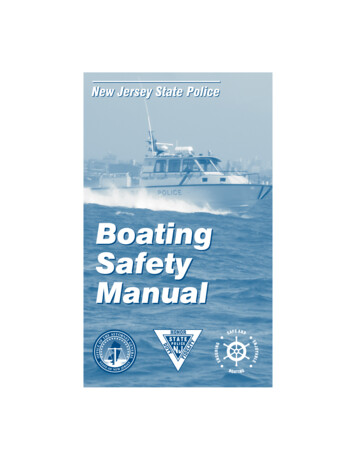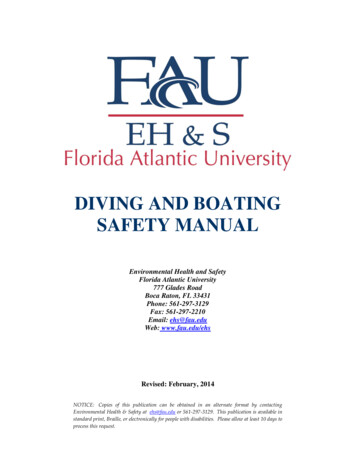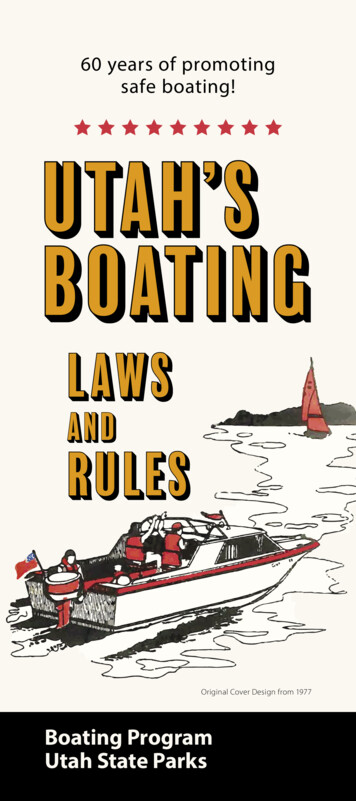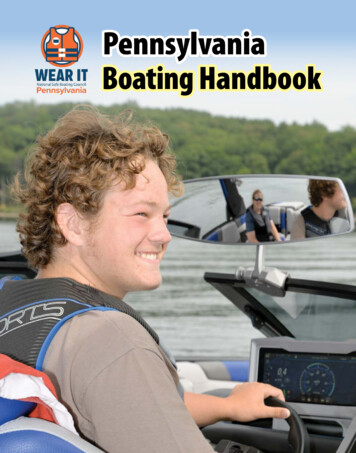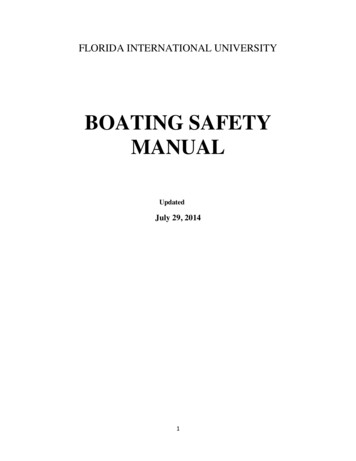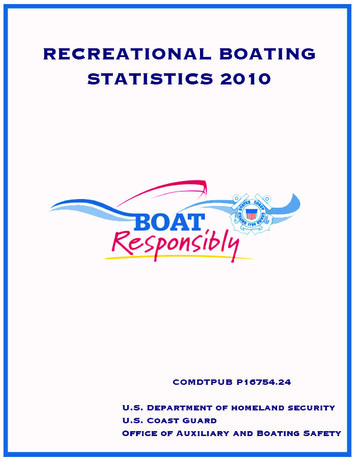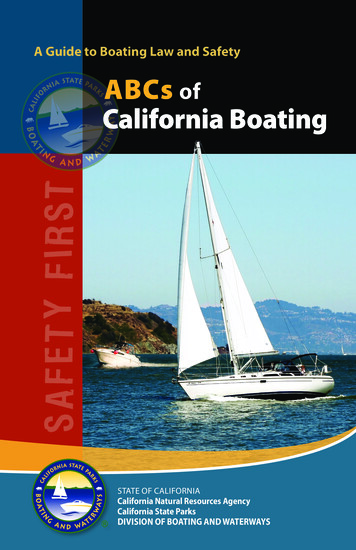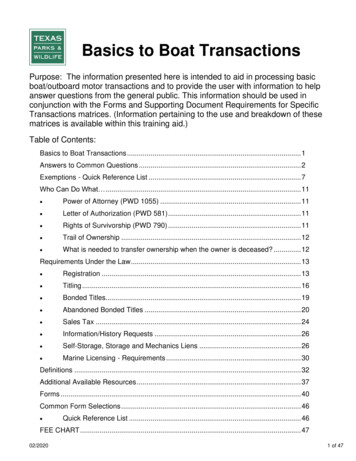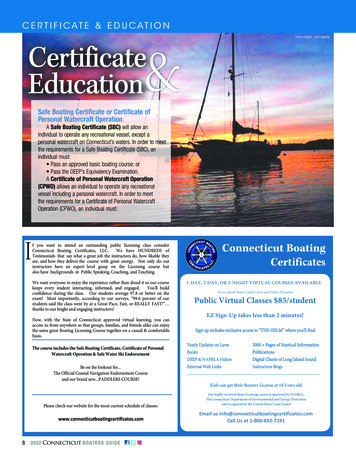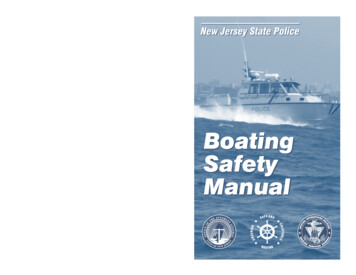
Transcription
NEW JERSEY STATE POLICEMARINE LAW ENFORCEMENT STATIONSTo best serve the public, the New Jersey State Police Marine Services Bureau hasoperational stations located strategically throughout the state in or near heavyboating areas as follows:New Jersey State PoliceNew Jersey State Police HeadquartersP.O. Box 7068West Trenton, NJ 08628-0068, (609) 882-2000Attn.: Marine Services BureauLAKEHOPATCONGAtlantic City Station12 North Rhode Island AvenueAtlantic City, NJ 08401, (609) 441-3586Bivalve Station2669 Ogden AvenuePort Norris, NJ 08349, (856) 785-1330Burlington Station601 East Pearl StreetBurlington City, NJ 08016(609) 387-1221NEWARKBAYMONMOUTHBEACHNJ STATE POLICEDIVISION HQBURLINGTONPOINTPLEASANTLake Hopatcong StationP.O. Box 341, Espanong RoadLake Hopatcong, NJ 07849(973) 663-3400Monmouth Station1250 Ocean AvenueSea Bright, NJ 07760(732) 842-5171Newark Bay Station400 Corbin StreetPort Newark, NJ 07114, (973) 578-8173North Wildwood StationChestnut and Central AvenuesNorth Wildwood, NJ 08260, (609) 522-0393OCEANBIVALVEATLANTIC CITYBoatingSafetyManualNORTH WILDWOODSOcean Station2 Point DriveWaretown, NJ 08758, (609) 693-8371Point Pleasant Station2001 Loveland PlacePoint Pleasant, NJ 08742, (732) 899-5050BALNA1921
LIGHTS REQUIRED ON BOATS BETWEEN SUNSET ANDSUNRISE AND AT ALL TIMES OF RESTRICTED VISIBILITYFigure 1Figure 2U.S. AIDS TO NAVIGATION SYSTEMLATERAL SYSTEM (As seen entering from Seaward)STARBOARD SIDEEVEN NUMBERED AIDSPORT SIDEODD NUMBERED AIDSFigure 3ororBBorInlandOnlyABWHITE LIGHT ONLYFLASHING (2)FLASHINGOCCULTINGQUICK FLASHINGISOFLASHING (2)FLASHINGOCCULTINGQUICK FLASHINGISOFI (2) 5SAFigure 5Figure 4ISOLATED DANGERAIDSRED LIGHT ONLYGREEN LIGHT ONLYANON-LATERAL AIDS9Figure 61Great LakesONLYG “9”FL G 4S8“2”FL R 6S2R “8”FL R 4SABR “A”FI(2) 5S“1”FL G 6SLIGHTororBABALIGHT56BCGC “9”CANFigure 8G“5”DAY BEACONPREFERRED CHANNELTO STARBOARDTOPMOST BAND GREENPREFERRED CHANNELTO PORTTOPMOST BAND REDRANGE AND DEGREE OF VISIBILITY OF LIGHTSInland and InternationalLocationVisible RangeDegreeof Visibility(In Nautical Miles)All-around light2/2SAFE WATER MARKERSWHITE LIGHT ONLYMORSE CODEMo (A)RED LIGHT ONLYCOMPOSITE GROUP FLASHING (2-1)NRW “N”M0 (A)ABGR “A”FL(2 1) G 6SMRLIGHTEDAND/OR SOUNDRG “B”FL(2 1) R 6S225360Side lights1/2112.5Stern light2/2135RW“A”ALess than 12M/12M to 50MorUNLIGHTEDDAY BEACONNUNPREFERRED CHANNELNO NUMBERSMAY BE LETTEREDCOMPOSITE GROUP FLASHING (2-1)2/32RN “6”BR “C”R“2”PREFERRED CHANNELNO NUMBERSMAY BE LETTEREDGREEN LIGHT ONLYMasthead lightLIGHTEDLIGHTED BUOY9orALIGHTED BUOYNSUDAY BEACONCGR“U”GRC “S”CANNUNRGN “C”GRG“G”DAY BEACONRW “N”NRW “N”CANUNLIGHTEDAND/OR SOUND
Table of ContentsNEW JERSEY SAFE BOATING . 1Boating Safety Education & Minimum Age Requirements .2Non-Tidal Boat License .3Navigation Rules.4CHAPTER 1Registration, Titling & Documentation . 6Vessel Titling.6Boat Registration .7Registration Required .7Documented Vessels .8Numbering System & Display .8Validation Decal .9Obtaining Applications .10Change of Residence.10CHAPTER 2Equipment . 11Muffling Device . 11Coast Guard Approved Equipment . 11Flame Arresters (Backfire Flame Control) . 11Sound Signaling Appliances For Vessels Less Than 20 Meters(65’6”) .12Personal Flotation Devices .12Wearing of PFDs by Children 12 and Under .14Fire Extinguishers .15Marine Sanitation Devices (MSDs) .16Visual Distress Signals: The Regulations .17Visual Distress Signals: Handling and Storage .18Visual Distress Signals Types .19Visual Distress Warning. .20Minimum Required Equipment by Length of Boat .21Meter-feet Conversions .24Rev. 03/11
CHAPTER 3Operator’s Responsibilities .25Power-Driven Vessels . 25International . 25Inland . 25Sailing Vessels & Vessels Under Oars . 26International & Inland . 26Lights Used When AnchoredInternational & Inland . 26Found Vessels. 27Boating Accidents/Duties In Case of Accidents . 27Speed . 28Operating a Vessel Under the Influence of Intoxicating Liquor,Drugs or Narcotics . 29Reckless or Careless Operation Forbidden . 32Personal Watercraft . 32Waterskiing . 34Skin Diving . 35Watercraft Noise Control . 35Racing . 36Race Test Permits . 36Loading Your Boat . 47Water Pollution and the Recreational Boater . 38Discharge of Oil Prohibited . 38Electrical Shock . 38CHAPTER 4For Your Protection .39Security Afloat . 39Report Stolen Boats and Equipment . 41Bargain Deals . 42Marine Radio Information . 42Float Plan . 42 & 43Equipment Checklist . 44Marine Law Enforcement Stations . 45Navigation Aids . 46
NEW JERSEY SAFE BOATINGThe objective of the boating safety program is to reduce therisk of loss of life, injury and property damage associated withthe use of the state’s waterways.The state recognizes the need for safe boating and highly recommends that the boating enthusiasts make themselves thoroughly familiar with all of the laws, regulations and other information contained in this booklet. Boating is best enjoyedwhen the boater is knowledgeable and diligent in observingsafety precautions. Rules and regulations quoted herein aremost commonly used.New Jersey has adopted the Navigational Rules InternationalInland and the Code of Federal Regulations as the standardsfor vessel equipment and operation. The Navigational Rulesand the Code of Federal Regulations can be purchased eitherat a boat supply store or through a boating catalog. In additionto these standards, other laws, rules, and regulations have beenadopted for the waters of this State.Consult local authorities for information on local ordinances.For more information on Boating Safety, Rules &Regulations, and Boating Safety Certificates,visit www.njsp.org/maritime.Boating Safety Course information may be located at:www.cgaux.org www.usps.org www.BOATUS.comBoating Safety Courses must be completed in person.1
BOATING SAFETY EDUCATION& MINIMUM AGE MANDATORY REQUIREMENTSAre you 16 years old or older?YesNoNoAre you 13 yearsof age but lessthan 16 yearsof age?Are you under13 years of age?YesNoNoYou cannot operateany power vesselon NJ waters.YesYesYou can operateany power vesselincluding personalwatercraft on NJwaters.Do you have a NJBoating SafetyCertificate?You cannot operateany power vesselon NJ waters.Do you have a NJBoating SafetyCertificate?YesYou may operatevessel poweredsolely by anelectric motor or avessel 12 ft. longor longer with lessthan 10 HP.1) There are NO EXEMPTIONS to N.J. age requirements.2) Out-of-state residents who are at least 16 years old and inNew Jersey for less than 90 days may operate a power vessel on the waters of the State of New Jersey if they possessa certificate issued by their state of residence or they havein their possession written proof of successful completionof a boat safety course approved by another state, the U.S.Coast Guard, or the National Association of State BoatingLaw Administrators (NASBLA).2
NON-TIDAL BOAT LICENSEAre you going to boat onnon-tidal water (Water wherethe tide does not change)?YesNoNo Non-Tidal BoatLicense required.Does one of the belowlisted exemptions apply?YesNoNon-tidal boatlicense required.A boat license is separate from the boating safety certificateand is issued by the Motor Vehicle Commission (MVC).Exemptions1) Vessel powered by a motor less than 1 HP or a 12 volt electric motor.2) A vessel 12 feet long or longer with less than 10 HP.3) While competing in an authorized race pursuant to a permitissued by the Division of State Police in the Department ofLaw & Public Safety.4) If the person is an out-of-state resident who has writtenproof of successful completion of a course substantiallysimilar to a NJ approved Boating Safety Course.3
NAVIGATION RULESAll vessels operating on the waters of this State are responsiblefor adherence to the Navigation Rules International/Inland.The rules as defined in COMDTINST M16672.2D, are appliedas set forth under the COLREGS Demarcation Lines.In addition, all vessels 12 meters (39’4”) and over in lengthare required to have on board a copy of the Navigation Rules,International/Inland, COMDTINST M 16672.2D, while operating on the waters of this State.Rule 5, LOOKOUTEvery vessel shall at all times maintain a proper look-out bysight and hearing as well as by all available means appropriatein the prevailing circumstances and conditions so as to make afull appraisal of the situation and of the risk of collision.Rule 6, SAFE SPEEDEvery vessel shall at all times proceed at a safe speed so that itcan take proper and effective action to avoid collision and bestopped within a distance appropriate to the prevailing circumstances and conditions.Rule 7, COLLISIONEvery vessel shall use all available means appropriate to theprevailing circumstances and conditions to determine if risk ofcollision exists. If there is any doubt such risk shall be deemedto exist.Rule 8, ACTION TO AVOID COLLISIONAny action taken to avoid collision shall, if the circumstancesof the case admit, be positive, made in ample time and with dueregard to the observance of good seamanship.If necessary to avoid collision or allow more time to assess thesituation, a vessel shall slacken its speed or take all way off bystopping or reversing its means of propulsion.4
Rule 9, NARROW CHANNELSA vessel proceeding along the course of a narrow channel orfairway shall keep as near to the outer limit of the channel orfairway which lies on its starboard side as is safe and practicable.Rule 14, HEAD-ON SITUATIONWhen two power-driven vessels are meeting on reciprocal ornearly reciprocal courses so as to involve risk of collision, eachshall alter its course to starboard so that each shall pass on theport side of the other.Rule 15, CROSSING SITUATIONWhen two power-driven vessels are crossing so as to involverisk of collision, the vessel which has the other on its starboardside shall keep out of the way and shall, if the circumstances ofthe case admit, avoid crossing ahead of the other vessel.Rule 16, ACTION BY GIVE-WAY VESSELEvery vessel which is directed to keep out of the way of another vessel shall, so far as possible, take early and substantialaction to keep well clear.Rule 17, ACTION BY STAND-ON VESSELA power-driven vessel which takes action in a crossing situation to avoid collision with another power-driven vessel shall,if the circumstances of the case admit, not alter course to portfor a vessel on its own port side.5
CHAPTER 1Titling, Registration, & DocumentationVESSEL TITLINGAll vessels longer than 12 feet in length must be titled.Is the vessel longerthan 12 feet?NoYou do notneed a boattitle.YesIs it a brand newboat purchase?You will needmanufacturer’scertificate oforigin.YesNoWas it purchasedfrom a New Jerseyowner?YesNoDid last registeredstate require a title?YesComplete theassignmentsection on theback of the titleand have sellersign it.NoTake most recent vesselregistration along with a notarizedsigned statement attesting tothe accuracy of the H.I.N.In addition to the H.I.N., you willneed to know the year, make & typeof boat, its length, material usedfor construction, the source ofpower & the proposed use (pleasureor commercial). Take all of thisinformation, along with your driver’slicense # (or corpcode if companyowned) to your local M.V.C.6
BOAT REGISTRATIONAll titled boats must also be registered. In addition, all powervessels, regardless of length, must be registered.If the boat is not titled, you will have to show proof of ownership. Any of the documents accepted for titling are also acceptable for registration.REGISTRATION REQUIREDEvery vessel in New Jersey waters shall be registered and numbered, except:a. Vessels operated under a federally approved numberingsystem of another state, operated on a transient basis;b. Documented vessels from other states operated in thisState in a transient status only;c. Vessels from foreign countries here temporarily;d. Public vessels of the United States, a state or subdivision or agency thereof;e. A ship’s lifeboat;f. Vessels used exclusively for racing while competingin an authorized race, or under permit issued from theNew Jersey State Police;g. A non-powered sailboat or vessel used exclusively onsmall lakes and ponds wholly within private lands;h. A non-powered inflatable, surfboard, racing shell ortender for direct transportation between a vessel and theshore and for no other purpose (i.e., dinghy);i. Non-powered Vessels 12 feet or less in lengthj. A non-powered kayak or canoe.7
DOCUMENTED VESSELS1. All documented vessels for which the owner maintains,owns, rents, leases or otherwise occupies space within thisState, other than on a transient basis, MUST be registeredwith this State according to the established fee schedule,but are not required to display numbers. Validation decalswill be issued and must be displayed on these vessels.2. Registration certificates must be carried on board the vesselat all times while the vessel is in operation.3. Those vessels documented under Part 67 of Title 46, Codeof Federal Regulations and required to register with thisState pursuant to NJSA 12:7-34.44a shall display a validation sticker on each side of the vessel in an area adjacentto the main steering station affixed to the vertical surfaceplainly visible at all times from both the port (left) and starboard (right) sides.NUMBERING SYSTEM & DISPLAY1. Boats will be numbered as follows;a. The registration numbers assigned shall consist of three(3) parts. The first part, known as the prefix, shall consist of the letters NJ, to indicate the state. The secondpart, known as the body, shall consist of not more thanfour (4) numbers. The third part, known as the suffix,shall consist of not more than two (2) letters.b. The parts shall be separated by a hyphen or an equivalent space equal to a number or letter.Examples:NJ-1234-ABNJ 1234 AB8
2. The registration number shall be;a. Painted on or permanently attached to each side of thebow (the forward half) of the vessel, read left to rightand in such position as to provide maximum visibility.b. In block characters not less three (3) inches in height.c. Of a color which will contrast with the color of thebackground (i.e., dark numbers on a light backgroundor light numbers on a dark background) and so maintained as to be visible and legible.3. No other numbers shall be carried on the bow of the vessel.VALIDATION DECAL1. The validation decal shall be placed on each side of the vessel, three (3) inches aft of the registration number.2. When the vessel is sold, it is the responsibility of the sellerto remove the decals.3. Each registered vessel must display valid decals.4. Expired registration decals must not be visible.Validation Decal 3” aftof the registration numberPlain block characters of acolor contrasting the backgroundNOT LESS than 3 inches in height9
OBTAINING APPLICATIONSApplications for motorboat registration may be obtained fromthe Motor Vehicle Commission. For more information, visittheir website at: www.state.nj.us/mvc.CHANGE OF RESIDENCEWhenever the owner of a vessel registered and numbered withthe State of New Jersey changes their address from that shownon their certificate of number, they shall, within seven (7) days,notify the Motor Vehicle Commission in writing of their newaddress. Record change forms are provided for this purposeand will be mailed upon request. This record change form mayalso be used to report a change(s) on a non-tidal boat license.10
CHAPTER 2EquipmentMUFFLING DEVICEEvery outboard motor, inboard motor or inboard/outboard motor in use or attached to a vessel operating on the waters ofthis State shall be equipped with a muffling system as suppliedby the manufacturer or installed by the owner. The mufflingsystem shall be maintained in good working order at all times.An exception to this requirement will be allowed for operationduring authorized races sanctioned by the United States CoastGuard, New Jersey State Police, or other operation with a racetest permit issued by the State Police.COAST GUARD APPROVED EQUIPMENT“Coast Guard approved” is equipment which has been approved by the Commandant of the U.S. Coast Guard and hasbeen determined to be in compliance with U.S. Coast Guardspecifications and regulations relating to the materials, construction and performance of such equipment. New Jersey statelaws conform to these equipment requirements.FLAME ARRESTERS (Backfire Flame Control)Gasoline engines installed in a motorboat or motor vessel after April 25, 1940, except outboard motors, must have a U.S.Coast Guard approved flame arrester fitted to the carburetor.For exceptions see 46 CFR 25.35.11
SOUND SIGNALING APPLIANCES FOR VESSELS LESSTHAN 20 METERS (65’6”)1. A vessel of less than 12 meters (39’4”) in length shall not beobliged to carry the signaling appliance prescribed above,but if it does not, it shall be provided with some other meansof making an efficient sound signal.2. A vessel 12 meters (39’4”) or more in length but less than20 meters (65’7”) shall be provided with a whistle. Thewhistle shall comply with the specifications listed in Annex3 of the Inland Navigational Rules Act of 1980.PERSONAL FLOTATION DEVICESNo person shall operate or allow any person to operate anyvessel in or on the waters of this State unless such vessel has aUnited States Coast Guard approved wearable personal flotation device (PFD) of the correct size for each person on board.Such PFDs shall be of the type(s) and number(s) required bythe United States Coast Guard for a vessel of the class operating on Federal or state navigable waters. This includes all vessels except surfboards, racing shells, rowing sculls and racingkayaks.TYPE IA Type I PFD has the greatest required buoyancy and is designed to turn most unconscious persons in the water from aface down position to a vertical or slightly backward position.The adult size device provides a minimum buoyancy of 22pounds and the child size provides a minimum buoyancy of 11pounds. The Type I is most effective for all waters, especiallyoffshore and ocean cruising, when there is probability of a delayed rescue.12
TYPE IIA Type II PFD is any approved wearable device designed toturn its wearer in a vertical or slightly backward position in thewater. The turning action is not as profound as with a Type I,and the device will not turn as many persons under the sameconditions as the Type I. An adult size device provides a minimum buoyancy of 15½ pounds, the medium child size providesa minimum of 11 pounds, and the infant and small child sizesprovide a minimum buoyancy of 7 pounds.TYPE IIIA Type III PFD is any approved wearable device designed sothe wearers can place themselves in a vertical or slightly backward position. While the Type III has the same buoyancy asthe Type II PFD, it has little or no turning ability. A Type IIIPFD comes in a variety of styles, colors and sizes. Many aredesigned to be particularly useful when water skiing, sailing,hunting, fishing or engaging in other water sports. Several ofthis type will also provide increased hypothermia protection.TYPE IVA Type IV PFD is any approved device designed to be thrownto a person in the water and grasped and held until rescued. Itis not designed to be worn. The most common Type IV devicesare a buoyant cushion and a ring buoy. All vessels 16 feet inlength or greater must carry a Type IV throwable PFD in addition to the required wearable PFDs.NOTE: Canoes and kayaks are exempt from carrying a TypeIV PFD.TYPE VA Type V is any special purpose PFD such as a survival orexposure suit.TYPE V HYBRIDA Type V Hybrid PFD is an inflatable device that provides aminimum of 7½ pounds of buoyancy deflated and 22 pounds13
of buoyancy when inflated. In order for the device to be acceptable for use on recreational boats, it must be worn when theboat is underway and the user is above on deck. When inflatedit turns the wearer similar to the action provided by a Type I, IIor III PFD. A Type V Hybrid PFD must be worn in accordancewith the information contained in the owner’s manuals supplied with each device.All PFDs that are presently acceptable on recreational boatsfall into one of these designations. All PFDs shall be U.S.Coast Guard approved, in good and serviceable condition andof an appropriate size for the persons who intend to wear them.Wearable PFDs shall be readily accessible and throwable devices shall be immediately available for use.WEARING OF PFDS BY CHILDREN 12 AND UNDERIn addition to the previously listed requirements, any child12 years of age or younger must WEAR a properly fitted U.S.Coast Guard approved PFD whenever the vessel is underway.If the child is inside a fully enclosed cabin that is a permanent,non-removable part of the vessel that is designed to carry passengers, then the child is not required to wear the PFD.This law does not apply to the following vessels:1. Vessels that are owned and operated by the United Statesor the State of New Jersey or an agency thereof; a countyor municipality; a volunteer first aid, rescue or emergencysquad, a search and rescue unit established within a fire district created pursuant to or a volunteer fire company whena child is on board as a direct result of being rescued froman emergency situation.2. Commercial vessels (any vessel longer than 65 feet operated for a purpose that requires a U.S. Coast Guard Operator’s or Master’s License).14
3. Ferries (any vessel longer than 65 feet operating on a shortrun on a frequent schedule between two points offering apublic service of a type normally attributed to a bridge ortunnel).FIRE EXTINGUISHERSAll fire extinguishers used on vessels must be U.S. Coast Guardapproved. Each fire extinguisher is classified by a letter and aroman numeral according to the type of fire it may be expectedto extinguish and the size of the extinguisher. The “letter” indicates the TYPE OF FIRE the extinguisher can put out.A- Fires of ordinary combustible materials.B- Gasoline, oil and grease fire.C- Electrical fires.Extinguishers approved for motorboats are hand-portable, ofeither B-I or B-II classification.Coast arbon Dioxide Dry Chemical(lbs)(lbs)415210Fire extinguishers must be carried on ALL motorboats thathave one or more of the following conditions which make theboat of closed construction:1. Inboard engines,2. Closed compartments under thwarts and seats where portable fuel tanks may be stored,3. Double bottoms not sealed to the hull or which are not completely filled with flotation materials,4. Closed living spaces,5. Closed stowage compartments in which combustible orflammable material is stowed, or15
6. Permanently installed fuel tanks.Dry chemical fire extinguishers without gauges or indicatingdevices must be weighed and tagged every 6 months. If thegross weight of a carbon dioxide (CO2) fire extinguisher is reduced by more than 10% of the net weight, the extinguisher isnot acceptable and must be recharged.Check extinguishers regularly to be sure that gauges are freeand nozzle is clear.MARINE SANITATION DEVICES (MSDs)A Marine Sanitation Device (MSD) must be certified as “typeapproved” or meet one of the exceptions provided by regulation.Boats 65 feet in length and under may use a Type I, II or IIIMSD. Boats over 65 feet are limited to installing Type II or IIIMSDs. Coast Guard certified devices are also labeled with theexception of holding tanks which are automatically certifiedunder the regulations if they store only sewage and flush waterat ambient air pressure and temperature.TYPE I MSD- Flow through; effluent USCG certified to 1000fecal coliform/100 ml, no visible floating solids standards.TYPE II MSD- Flow through; effluent USCG certified to 200fecal coliform /100 ml, 150 mg/1 total suspended solids standard.TYPE III MSD- USCG certified to no-discharge standard.All MSDs tested and certified by the Coast Guard will carry alabel with the name of the manufacturer and the certificationnumber. To obtain information about marine pumpout stationsplease visit the New Jersey Division of Fish and Wildlife website at www.njfishandwildlife.com, from there go to “Fishing”and then to “Clean Vessel Act.”16
VISUAL DISTRESS SIGNALS: THE REGULATIONSA visual distress signal is any device designed to show thatyour vessel is in distress and help others locate you. A widevariety of signaling devices, both pyrotechnic and non-pyrotechnic, can be carried to meet the requirements of the regulation. Visual distress signals may only be used in emergencysituations.Regulations require all recreational boats operating on U.S.coastal waters, including the Great Lakes, the territorial seasand those waters directly connected to the Great Lakes and theterritorial seas, up to a point where the waters are less thantwo miles wide, and boats owned in the United States whenoperating on the high seas to be equipped with visual distresssignals.The exceptions are during daytime (sunrise to sunset) operation for:1. Recreational boats less than 16 feet in length.2. Boats participating in organized events such as races, regattas or marine parades.3. Open sailboats not equipped with propulsion machineryand less than 26 feet in length.4. Manually propelled boats.These boats only need to carry night signals when used on thesewaters at night.“PYROTECHNIC VISUAL DISTRESS SIGNALING DEVICES” must be Coast Guard approved, in serviceable condition, unexpired and readily accessible. Launchers, producedbefore January 1, 1981, intended for use with approved signalsare not required to be Coast Guard Approved.USCG approved pyrotechnic Visual Distress Signals and associated devices include:17
1. Pyrotechnic red flares, hand held or aerial.2. Pyrotechnic orange smoke, hand held or floating.3. Launchers for aerial red meteors or parachute flares.“NON-PYROTECHNIC VISUAL DISTRESS SIGNALINGDEVICES” must carry the manufacturer’s certification thatthey meet Coast Guard requirements. They must be in serviceable condition and stowed to be readily accessible.This group includes:1. Orange distress flag.2. Electric distress light.No single signaling device is ideal under all conditions and forall purposes. Consideration should be given to carrying several types. For example, an aerial flare can be seen over a longdistance on a clear night, but for closer work, a hand-held flaremay be more useful.VISUAL DISTRESS SI
Boating Safety Course information may be located at: www.cgaux.org www.usps.org www.BOATUS.com Boating Safety Courses must be completed in person.
